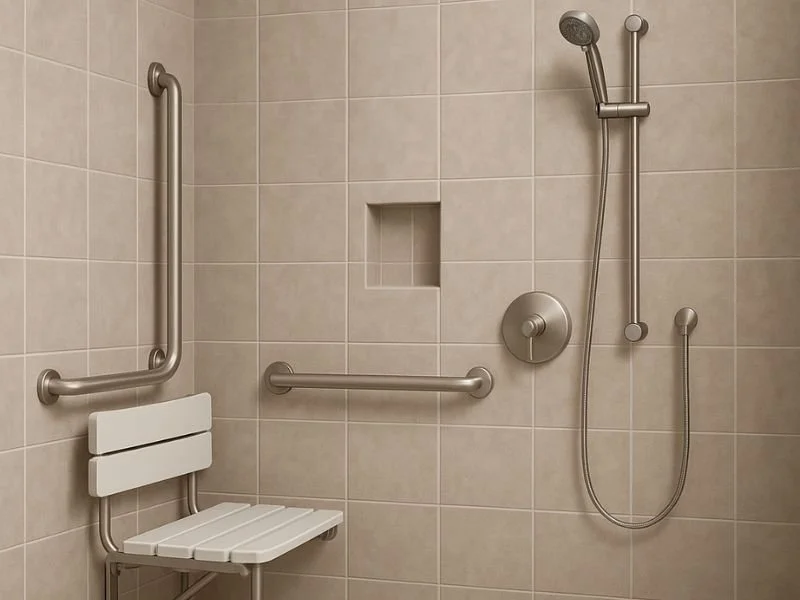Handicap Accessible Shower Guide: Wheelchair-Friendly Roll-In Shower Stalls & ADA Design Tips
Upgrading to a handicap accessible shower lets wheelchair users and seniors age in place safely-without sacrificing style. This comprehensive guide shows how to choose the right wheelchair accessible or roll-in shower, plan an ADA-compliant layout, and evaluate shower stall options that make your bathroom both beautiful and barrier-free.
Article Roadmap
What Makes a Shower “Handicap Accessible”?
Roll-In Shower vs. Walk-In Shower: Key Differences
ADA Roll-In Shower Requirements: Size, Threshold, and Drain
Designing a Barrier-Free Shower Stall for Wheelchair Users
Grab Bar Placement & Reinforced Shower Walls
Choosing a Shower Seat: Folding Seat vs. Built‑In Bench
Shower Heads & Handheld Showers for Wheelchair Accessibility
Curbless Shower Pans & Bases: Installing an ADA-Compliant Shower
Barrier-Free Shower vs. ADA-Compliant Shower: Key Distinctions
Installing Accessible Shower Stalls: Multi‑Piece & Tile‑Ready Options
Portable Shower & Transfer Showers: Options When Remodeling Isn’t Possible
Accessible Design Checklist for a Handicap Shower Stall
FAQ—Your Accessible Shower Questions Answered
1. What Makes a Shower “Handicap Accessible”?
A truly accessible shower eliminates physical barriers so someone in a wheelchair can enter the shower independently. Standard tubs require a 15-inch lift of each leg; a barrier-free shower brings that threshold to zero. Features that define a handicap shower include:
Barrier-free shower floor with a maximum ½-inch bevel.
Clear 60 × 30-inch shower stall interior so a wheelchair chair can turn.
Grab bar on at least two walls for support.
These elements create a shower solution that provides wheelchair accessibility while blending with modern shower design aesthetics.
2. Roll-In Shower vs. Walk-In Shower: Key Differences
A roll-in shower has no curb, letting wheelchair users roll directly onto the shower floor. A walk-in shower may include a low lip (≤ 2 inches) that ambulatory users step across. When choosing, consider:
| Shower Type | Best For | Splash Control |
|---|---|---|
| Roll-in shower | Full-time wheelchair access | Requires larger footprint and linear drain to keep water inside |
| Walk-in shower | Limited mobility, walker use | Low curb helps contain water with less floor space |
Both can be spa-like showers with rain heads, stone tile, and frameless glass.
3. ADA Roll-In Shower Requirements: Size, Threshold, and Drain
The ADA sets minimum dimensions to guarantee wheelchair clearance. ADA roll-in shower stalls must be at least 60 × 30 inches; showers must have a shower spray unit within reach of a seated user. Shower thresholds cannot exceed ½ inch, and shower pans must slope ¼ inch per foot toward a trench or center drain so water doesn’t pool.
4. Designing a Barrier-Free Shower Stall for Wheelchair Users
Start with an “L-shaped” grab bar (one horizontal, one vertical) on the shower wall opposite the entrance. This lets a user stabilize during transfers. Install a bench seat 17-19 inches high; folding bench seat models lift out of the way when not needed.
When you make your shower accessible, keep accessories simple: soap niches at 48 inches, thermostatic mixer at 40 inches, and a handheld shower head on a 60-inch slide bar.
5. Grab Bar Placement & Reinforced Shower Walls
Quality handicap showers rely on blocking. Use 2×10 lumber between studs so grab bars mount anywhere. Recommended layout:
Horizontal bar, 33-36 inches above shower floor.
Vertical bar near shower entry for balance.
Optional angled bar for diagonal grip.
This “tri-grip” configuration supports wheelchair access and standing transfers.
6. Choosing a Shower Seat: Folding vs. Built-In
A portable shower chair rolls over the lipless entry, ideal for rentals. A folding bench seat saves space in smaller bathrooms. A stone bench looks high-end but must include waterproof membrane and slope to drain-otherwise water leaking can rot framing.
Shower seats must support at least 250 lbs; check weight ratings before purchase.
7. Shower Heads & Handheld Showers for Wheelchair Accessibility
A handheld shower head with a 6-foot hose reaches seated positions easily. Pair it with a fixed rain plate so standing users still get a spa-like shower. Showers must have at least one spray unit capable of 1.8 GPM to conserve water.
Add an inline vacuum breaker to prevent cross-contamination, meeting ADA-compliant shower plumbing codes.
8. Curbless Shower Pans & Bases: Installing an ADA-Compliant Shower
Pre-sloped composite shower bases drop into a standard 60-inch alcove. Look for multi-piece shower kits that include walls with molded seats and shower accessories like corner shelves.
A curbless shower requires recessing the subfloor or adding a ramp outside the shower entry. Professional waterproofing membranes ensure water to drain stays inside the wet zone.
9. Barrier-Free Shower vs. ADA-Compliant Shower: Key Distinctions
Both a barrier free shower and an ADA-compliant shower remove obstacles, yet they serve different needs. A barrier free shower focuses on a zero-threshold shower entry so any user can glide from bathroom floor to shower pan without a trip edge. An ADA-compliant unit layers specific size rules, control heights, and turning radius so a wheelchair accessible shower meets code for public or multi‑family housing.
A barrier‑free walk in shower often features curbless stone tile that blends the shower floor with the surrounding space for a seamless spa-like shower feel. In contrast, an ADA roll in shower typically uses a trench drain, pre‑sloped pan, and tactile grab bar placement. Deciding which approach works best depends on whether the project is a private walk in shower remodel or a commercial retrofit that must satisfy inspectors.
10. Installing Accessible Shower Stalls: Multi‑Piece & Tile‑Ready Options
Factory‑made accessible shower stalls arrive in multi‑piece sections that slot together behind standard doorways—ideal when hallways are narrow. Tile‑ready pans give designers creative freedom to craft a one‑of‑a‑kind wheelchair accessible shower with custom mosaics and inlay borders. Whichever route you choose, make sure the shower stall is designed to slope ¼ inch per foot so water drains quickly and doesn’t migrate across the bathroom.
11. Portable Shower & Transfer Showers: Options When Remodeling Isn’t Possible
If you can’t remodel, a portable shower stall sets up on any level surface; a built‑in pump sends water off the floor into a nearby sink for drainage. Transfer showers (36 × 36 inches) fit tub alcoves, offering a hybrid between tub and full roll-in accessible shower.
Manufacturers like Freedom Showers supply pre‑framed pans with grab bars, curtain rods, and collapsible dams—ideal for phased renovations.
12. Accessible Design Checklist for a Handicap Shower Stall
Creating an accessible design that works for every type of handicap means balancing code with comfort. Use this quick list to verify your handicap shower stall (or complete ADA shower kit) checks all the boxes:
Shower door width: 36 inches clear or remove the door and opt for a weighted shower curtain for easier wheelchair access.
Entry threshold: ½‑inch beveled edge on tile or pre‑sloped shower base.
Roll in shower stalls must include a collapsible water dam to keep spray in the bathroom yet allow wheels to pass.
Install an L‑shaped grab bar on the shower wall nearest the entrance of the shower.
Use an adjustable handheld shower on a 60‑inch slide bar so wheelchair users can bathe independently.
Choose shower kits with factory‑reinforced walls; these accept future rails without opening tile.
Provide a shower threshold color contrast strip so low‑vision users perceive the edge.
Keep a spare rolling shower chair for guests—most showers for wheelchair users accommodate a 24‑inch turning circle.
Whether you’re installing a new shower unit or upgrading an existing enclosure, this list ensures your build offers true wheelchair accessibility and complies with ADA-compliant shower guidelines.
13. FAQ—Your Accessible Shower Questions Answered
-
They can be, but tax credits and local grants offset costs, especially when medical necessity is documented.
-
A handheld shower, slip-resistant tile, folding shower seat, and a grab bar at each wall corner.
-
Absolutely-frameless glass, stone mosaics, and steam generators create luxury without compromising wheelchair access.
Bullet-Point Recap
Minimum 60 × 30-inch roll-in shower stalls meet ADA clearance.
Zero-threshold curbless showers eliminate trip hazards.
Reinforced shower walls hold multiple grab bars for transfers.
Folding bench seat saves space; built-ins add spa comfort.
Handheld shower heads on slide bars serve all abilities.
Use linear drains and sloped shower pans to keep water inside.
Portable and multi-piece showers offer quick install for rentals.
Smart shower design ensures safety today and resale value tomorrow.









